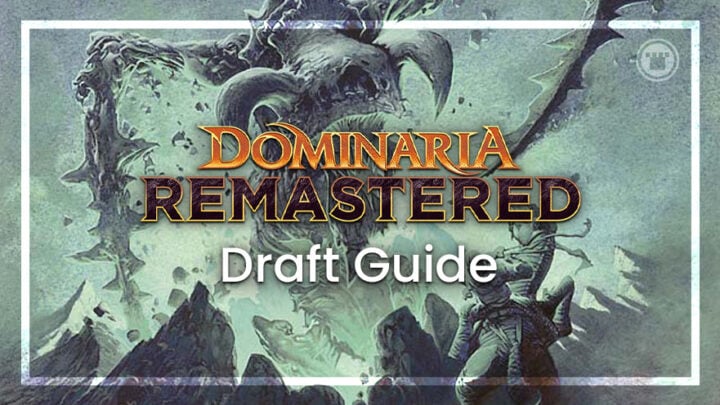Surprised to see another Draft Guide already? Sure, not all of us have quite had our fill of The Brothers’ War just a month after I previewed it here on Card Kingdom. But trust me — this is a special occasion. Dominaria Remastered is only the second remaster set to receive a full paper release, and it’s very different compared to its predecessor, Time Spiral Remastered.

Previous remaster sets, including the handful of Magic Online-exclusive ones, have always followed a literal and straightforward interpretation of that premise. They take a two or three set block from back in the day that had a fondly remembered Limited environment, compress it into a shortlist of the most memorable pulls and call it a day.
But just as remakes have grown more ambitious in the realm of film or video games, Wizards of the Coast has set its sights higher for Dominaria Remastered: a single, balanced draft format combining cards from an insane 28 different sets, showing the full rich tapestry of Magic’s original plane.
REIMAGINING REMASTERED SETS
I’d love to talk with the design team on Dominaria Remastered about the early stages of this project and how confident they were when they got this brief. It already seems quite daring to try and refine the wide-ranging mechanical themes of Time Spiral or Kaladesh blocks into a single coherent format. To try and make cards printed in Limited Edition Alpha (1993) play well alongside cards printed in Modern Horizons (2019) seems like a tall task.

It’s closer to being a Dominaria-themed cube than any of the prior Remastered sets, but this set still has to work with the traditional structure of commons, uncommons, rares and mythics. And pure game balance aside, it also has to pass a vibe check. It has to “feel right” as a distillation of Dominaria’s huge role in Magic’s history.
Some of that comes down to nostalgic card choices — even downshifting the rarity of past favorites so they can become a foundational part of every draft. But the most crucial decisions seem to be in the broad strokes of gameplay. Dominaria Remastered looks like a format leaning into the most fundamental and familiar aspects of the color pie, showing the common threads which bind all those sets together across the decades.
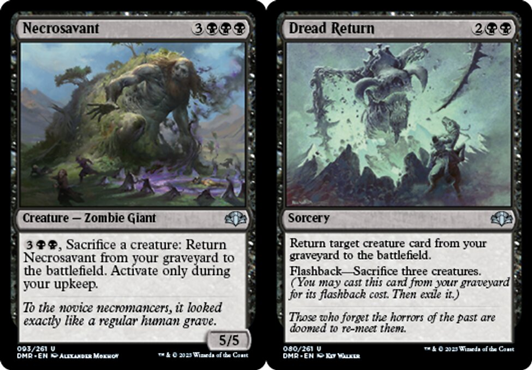
The result definitely looks and feels like a set from twenty years ago — which may or may not be a selling point for you. But to get there by cherry-picking the most compelling individual cards from all these disparate eras of Magic design means there’s bound to be a ton of nuance to every draft and game.
SHAPE OF THE FORMAT
Loosely-defined archetypes have regained popularity in current Limited design, and apart from a few powerful build-arounds, they look like the order of the day here, too. On my first read through of the spoiler, I definitely got tricked into holding back on certain themes or colors, waiting for support cards and gold uncommons which would really multiply their impact.
For the most part, that’s not how decks in Dominaria Remastered are going to work. Instead, you should try to evaluate each card and each color on face value. Lifegain spells aren’t here to trigger engines like Markov Purifier or Cleric Class — they’re for keeping you alive. You aren’t drafting that clunky old Ovinomancer to enable some landfall payoff — he IS the payoff!
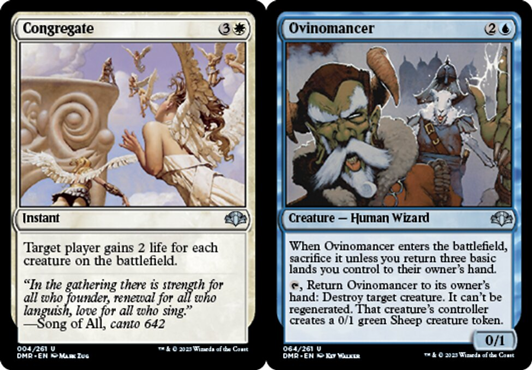
The power in most decks will be found in key interactions between specific cards in your colors, and in balancing your access to all the fundamental resources: life, cards and mana. That said, most players (including myself) find it easier to think about deck construction starting with their colors. So, what does this frankenstein draft format look like from that perspective?
Dominaria Remastered offers very little color-fixing, even in green, which pushes me toward conservative “one-and-a-half-color” deck building. To reinforce this, the color pair synergies seem deliberately constructed to have one dominant color providing the bulk of the curve, with some key support spells from the second.
The uncommmon Lairs and smoother draws from cycling cards give just enough fixing to help splash off-color bombs, but I think most of the time you’ll know when a rare is worth that investment.
Blue/white: Flicker & Bounce
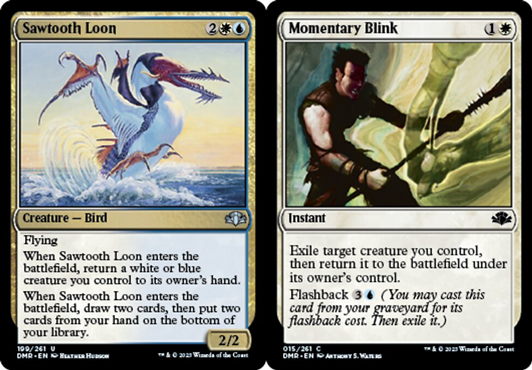
The gold cards here are clear indicators that something resembling a “Flicker” deck is on offer. Just be prepared for much clunkier and less efficient gameplay than the Soulherder-fuelled smoothness of modern Draft formats.
Momentary Blink is the only exile-then-return effect, so you’ll often need to actually bounce cards to hand to recur their enters-the-battlefield abilities. Don’t get squeamish about firing off Deliver on your own Floodgate or Sawtooth Loon! If you want to recapture the utility of re-triggering Man-o’-War at instant speed, you can try putting one under your Wormfang Drake and then bouncing said Drake at an opportune moment.
Speaking of effects to recur, blue generally has the stronger ETB creatures and a potent air assault between Cloud of Faeries, Wormfang Drake and Sawtooth Loon. So, unless you can get some truly insane Auramancer value, I’d recommend blue as the dominant color here — with an eye to splash in a powerful ETB from a third color if I can.
Black/white: Managed Self-Damage
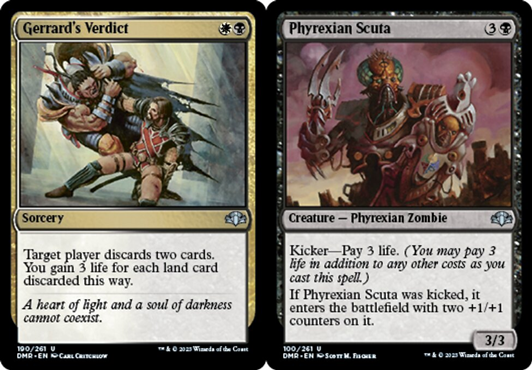
As I hinted above, you shouldn’t waste your breath looking for any higher meaning in the space between white’s excessive lifegain and black’s reckless self-damage. Having the spare juice to sustain multiples of Wretched Anurid, Flesh Reaver and Phyrexian Scuta is often its own reward!
White’s default plan for ending the game can be agonizingly slow, and trying to support black’s best creatures with just Urborg Syphon-Mage is simply agonizing. So the whole here is definitely much more than just the sum of its parts.
It’s still an extremely loose, draft-the-best-cards kind of strategy. Just be aware that if you have the opportunity to load up on the oversized black nasties through pack one and two, doubling back for Spirit Link and Prevent will let you really get the most from them.

White/red: Auras & Enchantments
There’s only a few color pairs where specific uncommons really make or break you, and for some reason they all seem to include red. In this case, our build-arounds are Mesa Enchantress, Valduk, Keeper of the Flame and Tiana, Ship’s Caretaker.
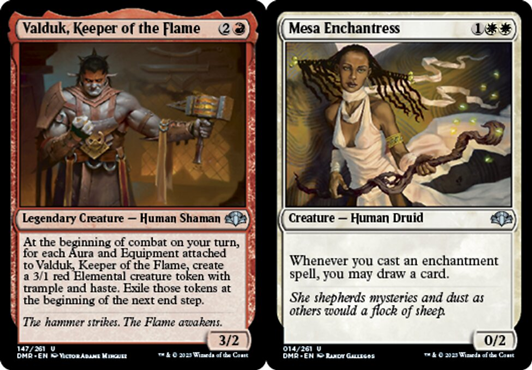
The Enchantresses give you some of the best card draw in this format, while Valduk is the ideal recipient of Griffin Guide, Spirit Link and Lightning Reflexes.
Tiana is a bit more marginal. Since she naturally has the keywords granted by your main auras, you’re better off playing her out after you’ve suited up something else — giving you the chance to immediately reload even if they have removal. She does really look good when you can loop the combat-trick mode of Lightning Reflexes every turn…
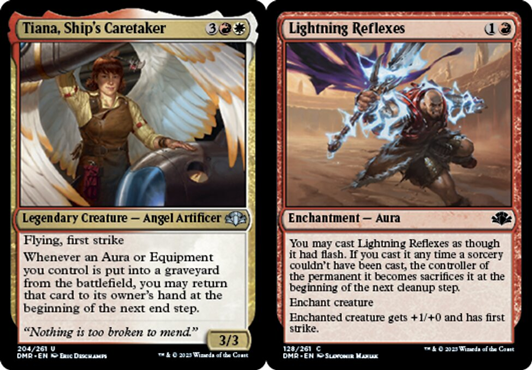
If you can’t find Valduk, just put your stat auras on things with good keywords, like Ridgetop Raptor or Kjeldoran Gargoyle. Vigilant Sentry can further boost these beasties once you cycle or trade your way to threshold status. Thran Golem is the luxury option and an obvious game winner with Spirit Link on top.
Splashing can be tricky when you’re already dealing with the inherent inconsistency of auras. But if you do feel brave, Quicksilver Dagger is basically a fourth uncommon build-around, while Twisted Experiment and Seton’s Desire offer extra Tiana synergy.
White/green: Threshold
I always thought Wizards should bring Threshold back for some current-day Standard set. Here we get the next best thing, led by Odyssey’s iconic Mystic Enforcer.
This thing used to be a rare, in case the 6/6 flying with anti-removal protection didn’t tip you off! Now we can enjoy the mighty nomad as our signpost uncommon, backed up by a wealth of slightly lesser payoff creatures.
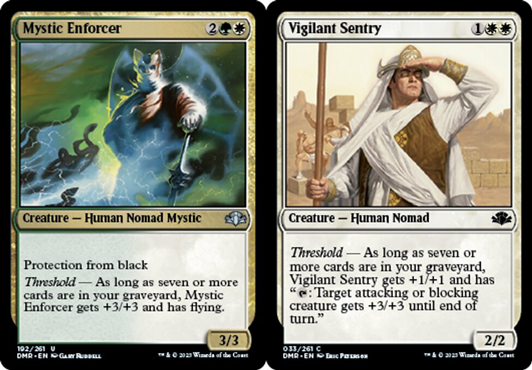
You generally want to take as many copies of these as you can once you start picking them since you can never have too many stats and they can all share the benefits of reaching threshold. Battlefield Scrounger is the one exception. I can’t really say whether potentially giving up Threshold to blow up a block on one turn is good enough for me, but at least it’s a backup curve-topper for the Enforcer.
In between grabbing Threshold creatures, load up on everything that can speed you towards seven cards in graveyard while slowing the game down overall. Cycling cards, Crop Rotation, Faadiyah Seer, Mind Stone, proactive instants and sorceries like Nature’s Lore — it’s all important.
Your best splash here is likely red, since there’s a lot of good cycling synergies and cycling cards there. Getting to cast the Chaos side of Order//Chaos is also a nice assurance once you’re ready to swing in with threshold buffs.
Blue/black: Classic Control
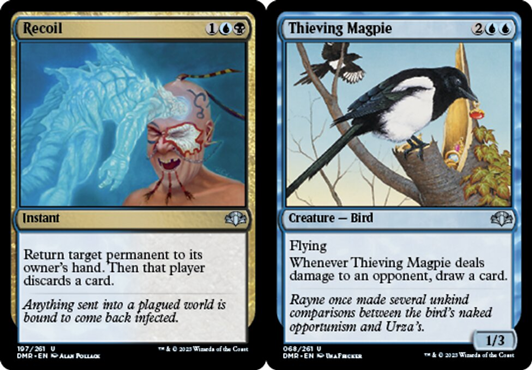
It’s hard to know what to explain here; there’s not a lot of synergy to be had in blue/black — just some fundamentally powerful cards. Unlike Magic formats originating in 2022, this one looks like it will heavily emphasize card advantage, so getting to cast Recoil a few times per game gets you most of the way to winning.
Make sure to play 17 or 18 lands, slow opponents down with Terror and Counterspell and then slowly grind up an advantage using draw engines like Undead Gladiator and Thieving Magpie.
Blue has some of its all-time favorites here in Counterspell, Man-o’-War, Fact or Fiction, Careful Study and Circular Logic, so I’d slightly favor it if I had to choose a main color between the two. But mostly it’s just important to have a lot of land, a lot of card advantage and some plan to eventually win — whether that’s Glintwing Invoker activations, an unblockable Evil Eye, Dread Return for something huge or the classic “Stroke you for 14.”
Blue/red: Storm!
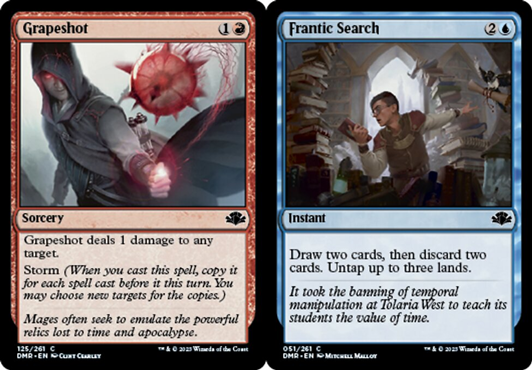
I’ll admit, this is not what I expected out of a slower-paced, lower-synergy Limited archetype. But Storm is both a landmark of Magic history and one of the all-time beloved Cube Draft decks, so I guess this cube-like nostalgia set is a decent fit.
If you’ve never before had the chance to explode somebody with Grapeshot or Empty the Warrens, please fasten your seatbelts and keep hands and feet inside the ride…
The Storm gameplan is a non-deterministic combo, meaning you never really know exactly how or when you’re going to win. Use chump blockers and a bit of interaction to slow the game down, draw cards and build up as many resources as possible for your One Big Turn.
Your top priority is cards that either don’t cost mana or that refund mana when played: Coal Stoker, Cloud of Faeries, Frantic Search, Peregrine Drake, Snap, Turnabout and Skirk Prospector. That last one is also notable for making Mogg War Marshal and Festering Goblin mana-neutral while in play, and turning a medium-size Empty the Warrens into a huge mana advantage.
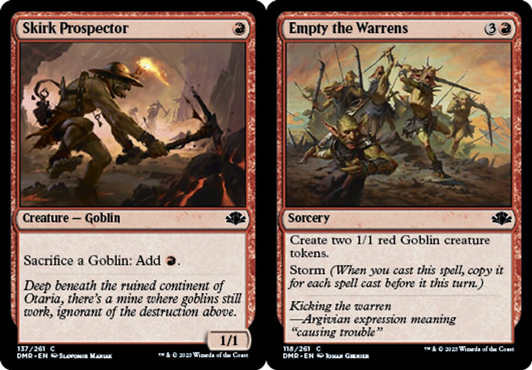
Even if chaining these cards together doesn’t do a lot for your board state (like targeting Cloud of Faeries with Snap and then playing it again), you’ll quickly build up the “Storm Count” of spells cast during the turn. Eventually, either you’ll be able to kill your opponent with Grapeshot copies or just put an unstoppable amount of power and toughness into play with Empty the Warrens and Storm Entity.
Besides the limited range of finishers, your possibilities for Storm are wide open — particularly if you’re able to splash. Figuring out which cards do or don’t work well inside this weird little machine is half the fun of the deck!
That said, you should remember that activated abilities, like cycling or the mana ability of Elvish Spirit Guide, do not count as casting those spells and cannot raise that turn’s storm count. But your opponent attempting to play their own cards does!
Green/blue: Ramp
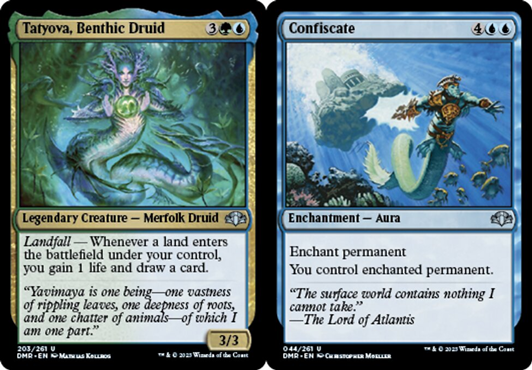
Another bare-bones, fundamental strategy here: play many lands, cast biggest spells! Again, blue is carried along by some immensely powerful eternal staples, except this time we’re adding in green for mana ramp and massive threats instead of black’s removal suite.
My first concern when drafting this sort of deck is getting enough great blockers to survive the early game without removal. Because Dominaria Remastered adheres closely to the classic color pie, neither blue nor green gets the privilege of cheap creature removal the way it does in modern sets. You must rely on Snap, Ovinize and Horseshoe Crab to hold the line until you build up enough lands.

Once you reach “enough lands,” lean heavy on whatever big rares you were able to snag and hope there’s no answers available to your opponent. If no big rares graced your draft, you’ll have to substitute high-impact uncommons like Aven Fateshaper, Confiscate, Ovinomancer and Kavu Primarch.
It shouldn’t be too hard to win the late game, though, so long as you are diligent about hitting land drops and including a bit of incidental card draw to balance your resource flow out. Remember to include any and all mechanics that let you scale and smooth draws in the late game. Cycling, threshold and mana sink abilities all help immensely.
Red/black: Gob Zombie
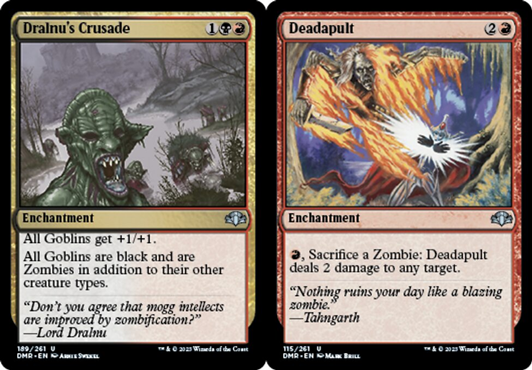
Look, there’s nothing that screams “red Magic” like a bunch of goblins. Goblins are at their most-red-Magic when attacking and then being sacrificed for even more damage by cards like Goblin Bombardment. Black is also very passionate about sacrifice, and while it struggles to muster more than a token Goblin, it can very reliably get its hands on some Zombies.
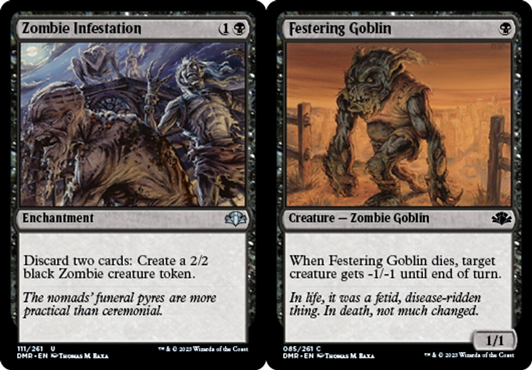
Thus we arrive at the perfect red/black Limited archetype, and also a pretty good stage-name for a glam rocker.
Without the good luck to open Pashalik Mons or Siege-Gang Commander, though, your only way to harness the power of goblin ballistics is with Deadapult. This down-shifted ex-rare is already very powerful alongside Undead Gladiator or Zombie Infestation. But once you pick up a Dralnu’s Crusade or two, suddenly this deck really begins to come together.
Ultimately, you might be able to trade out the multiple-enchantment-sacrifice-engine for just some huge creatures if you find them in your colors. But trust me, the extra work in drafting is worth the rewards.
If you see one of Deadapult or Dralnu’s Crusade early, you can just start out drafting either zombies or goblins by themselves as appropriate, and hopefully snag the other by the end of pack 3.
Green/black: “The Rock”
Nostalgic green-black midrange, referred to by Mark Rosewater using its most nostalgic name, is just one more way Wizards has tried to tie Dominaria Remastered into the game’s early history.
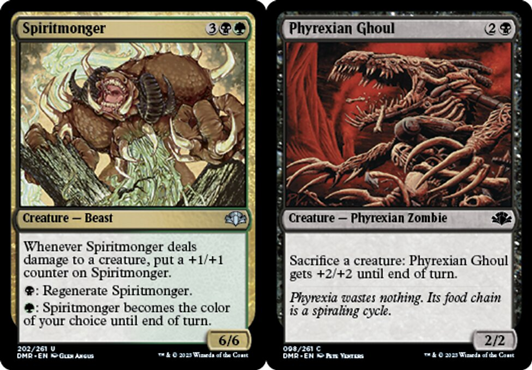
The archetype was popularized at the height of Dwayne “The Rock” Johnson’s pro-wrestling career, during which he frequently reminded his opponents of “the millions AND MILLIONS” of fans watching his every move.
Before Spiritmonger was printed in Apocalypse, the main finisher was Deranged Hermit, who brought along his millions (AND MILLIONS) of loyal squirrel tokens. Eventually, the Hermit lost his spot in the deck to Spiritmonger, but the name stuck — and it has remained stuck to any and all GB midrange decks ever since.
I’m lecturing on history here because I promise, you already know how this deck works. Play Spiritmonger, Terravore, Necrosavant, Stonewood Invoker and any other good creatures that scale into the late game. Use Deadwood Treefolk and Urborg Uprising to stay ahead on cards and recur utility creature effects like Faceless Butcher and Cacking Fiend.
Set up your “millions” with token makers Symbiotic Beast, Squirrel Nest and Zombie Infestation, then cash them in with Kavu Primarch, Phyrexian Ghoul and Dread Return. Grind your opponent’s face into your superior quality spells and cut a big, eyebrow-raised promo. For old time’s sake.
Red/green: Cycling
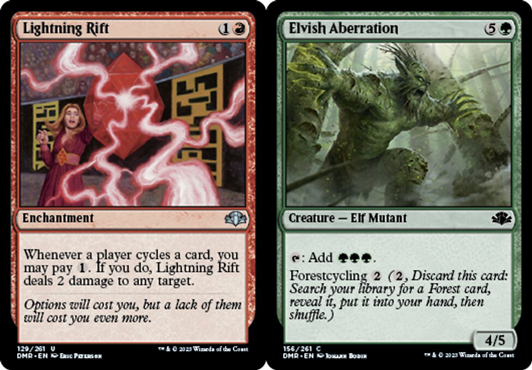
To me, this archetype is one of the more subtly shocking design decisions in Dominaria Remastered. Not in that it was included at all. Cycling was and remains a popular backbone of the game’s mechanics.
No, it’s the color combination it was assigned to. Simply put, Astral Slide was the cycling deck of the day, running mostly red/white cards with Astral Slide and Lightning Rift as the payoffs, and Exalted Angel (due to its synergy with Slide) as the big finisher.
However, the developers of this set have decided it’s better without Astral Slide (not without reason), so we find the cycling deck dependent on Lightning Rift and Invigorating Boon instead. Assuming you’re lucky enough to find a copy or two of those payoff enchantments early, the sheer narrow-mindedness of this archetype can make it a safe option to lock in for a first-time Dominaria Remastered Draft run.
Just grab every card with a cycling cost you can pay the cost for (to cycle, not to cast) and then every copy of said enchantments. As with Storm, you only need a minimal defense to get the ball rolling. Use Rift triggers to wipe out any defending creatures, pump your team with Boon and crash through for lethal!
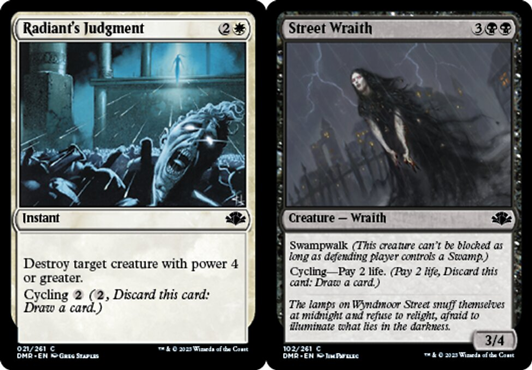
A WINDOW TO A DIFFERENT TIME
My gut reaction to the announcement of Dominaria Remastered was skepticism borne of product exhaustion. And after the rush job Wizards did previewing the set, I can understand if a lot of players switched off. But I’d sincerely recommend giving this format another look.

Obviously Wizards has taken care to litter Dominaria Remastered with extra goodies — cool new artwork and valuable Commander reprints. But for Draft and Sealed, I think the set has its own strong appeal as a sort of first-principles reconstruction of core Magic gameplay. It does actually feel a bit like a Core Set, albeit with a lot more stuff going on in the minutiae.
Maybe you fondly remember playing all these cards in Limited the first time around and are curious how they hold up. Or perhaps you’re younger in Magic years, and you’re after a live-fire history lesson. Either way, cracking a box of Dominaria Remastered is going to feel like uncasking fine whisky — complex in tone, distilled for potency and aged to perfection.

Tom’s fate was sealed in 7th grade when his friend lent him a pile of commons to play Magic. He quickly picked up Boros and Orzhov decks in Ravnica block and has remained a staunch white magician ever since. A fan of all Constructed formats, he enjoys studying the history of the tournament meta. He specializes in midrange decks, especially Death & Taxes and Martyr Proc. One day, he swears he will win an MCQ with Evershrike. Ask him how at @AWanderingBard, or watch him stream Magic at twitch.tv/TheWanderingBard.

